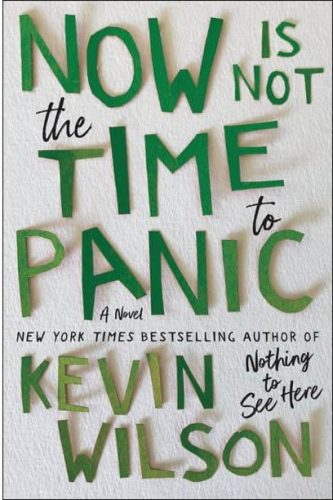“Is that why we do anything in this life? To feel it vibrate along the line that starts at birth and ends way way way after we die?”
I would’ve loved to have met Kevin Wilson when he was a kid. I imagine he was angsty, awkward, quirky and brilliant—because he populates his novels with children and teenagers that are, well, angsty, awkward, quirky and brilliant. They’re unlike any other characters I’ve come across in fiction, and I want to pull them into my arms and hold them safe forever.
Case in point: in his original, devastating, funny as hell new book, Now Is Not the Time to Panic, Wilson gives us Frankie Budge and Zeke Brown, two sixteen-year-old outliers in Coalfield, TN who are simply trying to survive the long, hot summer of 1996. Only—their burgeoning friendship offers up a strange and pivotal moment that comes to define both of their lives.
Frankie and Zeke don’t just want to go swimming, eat junk food, and practice kissing (although those things are nice); they want to create something together to push boundaries and show off their growing talents in writing and drawing. In a moment of seemingly divine inspiration, Frankie comes up with an eerie catchphrase—The edge is a shantytown filled with gold seekers. We are fugitives, and the law is skinny with hunger for us—and Zeke pairs it with a likewise eerie illustration.
They put words and pictures together on a poster, which, in an especially amusing scene, Frankie splatters with blood from a pricked finger. Using a stolen Xerox machine, they make copies of the poster and clandestinely hang them up all over Coalfield and beyond. Mayhem ensues, shocking not just Frankie and Zeke but readers as well.
In Now Is Not the Time to Panic, Wilson pushes us to consider what art is, and how it brings people together—or not. He gets us thinking about the nature of obsession, and the lengths we go to in order to feel seen and understood. Above all, he makes us question how in the world we ever made it through the torments of high school. “To be a teenager,” he writes, with such soul, “it takes very little to think that someone else might actually know who you are, even as you spend all your time thinking that no one understands you. It’s such a lovely feeling.”
It is precisely the unrelenting pursuit of this “lovely feeling” that serves as the beating heart of Wilson’s deeply affecting story.
– Laura Anne Bird
- Northwoods Author Amy Pease Interview and Book Recommendations - April 29, 2024
- Still True author Maggie Ginsberg:Interview and Book Recommendations - September 14, 2022
- When wood and words come together:A children’s picture book is born - June 30, 2022


